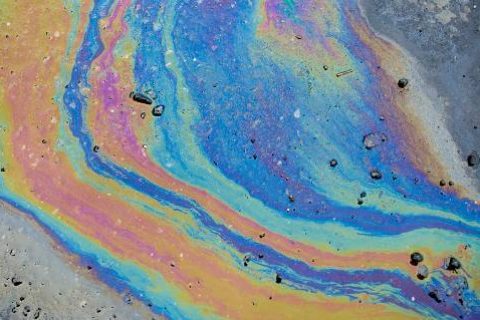Benzene Exposure
Benzene is a sweet-smelling, colorless and flammable liquid. It’s one of the most common chemicals produced in the United States with a wide range of uses from plastics to drug manufacturing. But benzene exposure may cause several short-term health problems as well as several kinds of cancer.

Benzene may be all around you at any time — it forms both naturally in the environment and through human activities. You might find it, for example, in the smoke from a forest fire or a cigarette. Benzene is known to cause cancer in humans, according to three different U.S. and international agencies.
Benzene ranks in the top 20 most widely produced chemicals in America and is frequently used to make other chemicals. It’s used in the manufacture of plastics, rubber, synthetic fibers, detergents, medicines and pesticides.
It also occurs naturally in crude oil and gasoline and may even form in food and beverages as a result of chemical reactions between the ingredients or packaging.
In addition to several types of cancer, benzene exposure can cause other immediate or long-term health issues.
How Benzene Exposure Happens
You’re most likely to be exposed to benzene around gas stations or through cigarette smoke. You may also be exposed in your home or workplace because benzene is used in paints, furniture wax and other common household items. But if you work in an industry or profession that uses benzene, you are likely to face much greater exposure.
The U.S. Occupational Safety and Health Administration sets airborne benzene exposure limits for workplaces. OSHA set the daily maximum safe level at 1 parts-per-million, or 1 ppm. That means 1 part benzene for every 1 million parts of air over the course of an 8-hour day. The short term exposure limit is 5 ppm for any 15-minute period.
The U.S. Environmental Protection Agency sets the maximum benzene level in drinking water at 5 ppm.
Signs and symptoms of excessive benzene exposure — through either breathing it in or swallowing food and beverages containing it — can differ from one another. But symptoms are likely to show up within a few minutes to several hours after it happens, regardless of how you were exposed.
Signs & Symptoms of Airborne Exposure
- Confusion
- Dizziness
- Drowsiness
- Headache
- Rapid or irregular heartbeat
- Tremors
- Unconsciousness
Signs & Symptoms of Ingested Exposure
- Convulsions
- Dizziness
- Drowsiness
- Rapid or irregular heartbeat
- Stomach ache or irritation
- Vomiting
Getting benzene in your eyes or on your skin can cause severe irritation. High levels of benzene, whether breathed in or swallowed, can also kill you.
Benzene in Recalled Sunscreen
Consumers may have also been exposed to benzene in recalled Aveeno and Neutrogena aerosol sunscreen products made by Johnson & Johnson.
Johnson & Johnson issued a recall in July 2021 after lab testing found benzene in some of its aerosol sunscreens, including: Aveeno Protect + Refresh aerosol sunscreen, Neutrogena Beach Defense aerosol sunscreen, Neutrogena Cool Dry Sport aerosol sunscreen, Neutrogena Invisible Daily defense aerosol sunscreen and Neutrogena Ultra Sheer aerosol sunscreen.
People who used the recalled sunscreens and later received a cancer diagnosis are filing sunscreen lawsuits against J&J.
Benzene in Recalled Dry Shampoo
In December 2021, Procter & Gamble issued a dry shampoo recall after certain products tested positive for benzene. The recall included popular brands such as: Waterl<ss, Pantene, Aussie, Herbal Essences, Hair Food and Old Spice.
According to P&G, it found “unexpected levels” of benzene in the propellant used to spray the product. Though the company advised consumers to stop using the recalled products immediately, it said the levels of benzene in recalled products aren’t expected to cause health problems.
Benzene Exposure Linked to Leukemia
Long-term exposure of a year or more can cause blood disorders ranging from anemia to leukemia or other cancers. This is true even if the amount you are exposed to is minor.
Health and pollution regulators around the world have determined that benzene is carcinogenic — it is known to cause cancer or helps cancer grow. These agencies rely on scientific research based on laboratory, animal and human studies.
- “Known human carcinogen” – U.S. Environmental Protection Agency
- “Carcinogenic to humans” – International Agency for Research on Cancer
- “Known to be a human carcinogen” – National Toxicology Program
A 2010 analysis in the journal Environmental Health concluded that “exposure to benzene at work increases the risk of leukemia.” Researchers analyzed 15 studies and said workers routinely exposed to benzene on the job had a 40 percent higher risk of developing leukemia than people who didn’t work around the chemical.
They also found that the more exposure a worker experienced, the higher the risk.
Cancers Associated with Long-Term Benzene Exposure
- Acute lymphocytic leukemia
- Acute myeloid leukemia
- Chronic lymphocytic leukemia
- Chronic Myeloid Leukemia
- Multiple myeloma
- Non-Hodgkin lymphoma
A 2004 study in the Annals of Work Exposures and Health found that even exposure levels considered safe can increase a worker’s risk in the long term. Scientists with the U.S. National Cancer Institute studied Chinese shoe factory workers exposed to glues containing benzene. They compared them to clothing factory workers who were not exposed to the chemical.
After 16 months, they found that the shoe factory workers had fewer white blood cells than the clothing workers. The types of missing white cells were an indication of bone marrow disorders, and a warning sign for possible leukemia.
Many people who believe they developed cancer as the result of benzene exposure in their workplace have filed Benzene lawsuits, with some receiving settlements and verdicts worth millions of dollars.
Camp Lejeune and Benzene Exposure
People living or working at U.S. Marine Corps Base Camp Lejeune in North Carolina from 1953 through 1987 were potentially exposed to benzene-contaminated drinking water. The water also contained industrial solvents and other chemicals.
Benzene exposure at Camp Lejeune may cause cancer, including myelodysplastic syndromes, multiple myeloma, non-Hodgkin lymphoma and leukemias. Other health conditions associated with benzene exposure include aplastic anemia and miscarriage.
An individual’s risk of developing cancer or another condition from contaminated Camp Lejeune water depends on the duration and intensity of exposure and the person’s general health.
How to Reduce Exposure Risks
There are several ways to reduce your exposure to benzene. Avoiding cigarette smoke is one of the most effective ways, as cigarettes are a major source of benzene. If you’re a smoker, quitting can reduce your exposure.
Using gas stations with vapor recovery systems can protect you from exposure. Avoid getting gasoline on your skin or clothes. And don’t leave your car idling — exhaust fumes contain the chemical.
If you work around benzene, use personal protective equipment such as protective clothing and masks. Or talk to your employer about switching to non-benzene solvents or other chemicals if possible. Try to limit your exposure to fumes that contain the chemical as well.
What to Do if You Are Exposed to High Levels of Benzene
In the event of a benzene release or spill, the best thing to do is get away from it or remove it from your skin and clothes as quickly as possible.
If it’s released into the air, move to fresh air immediately if you can. But it may be better to stay where you are and “shelter in place” if the release has been contained.
If you think you’ve been exposed, you should remove your clothes and wash your entire body with soap and water. Don’t pull contaminated clothes over your head — the benzene may get in your eyes. Cut the clothes off instead.
If you get benzene in your eyes, rinse them for 10 to 15 minutes with water. Remove contact lenses and put them with the contaminated clothes. You should never wear the contacts again.
Put the contaminated clothes into a plastic bag and seal it. Then put that bag in another plastic bag and seal the second one. Leave them for first responders or hazardous materials crews to pick them up and dispose of them.
Testing & Treatment for Exposure
There are lab tests that can measure benzene levels in your blood, breath or urine. But they can only detect a recent exposure and cannot predict future health effects.
Sudden exposure to high levels of benzene requires a hospital treatment. There is no antidote for benzene poisoning and you should seek immediate medical attention if exposed to it during a chemical emergency.
You should talk to your doctor if you think you’ve experienced long-term benzene exposure.
21 Cited Research Articles
Consumernotice.org adheres to the highest ethical standards for content production and references only credible sources of information, including government reports, interviews with experts, highly regarded nonprofit organizations, peer-reviewed journals, court records and academic organizations. You can learn more about our dedication to relevance, accuracy and transparency by reading our editorial policy.
- Procter & Gamble. (2021, December 17). P&G Issues Voluntary Recall of Aerosol Dry Conditioner Spray Products and Aerosol Dry Shampoo Spray Products. Retrieved from https://news.pg.com/news-releases/news-details/2021/PG-Issues-Voluntary-Recall-of-Aerosol-Dry-Conditioner-Spray-Products-and-Aerosol-Dry-Shampoo-Spray-Products/default.aspx
- Agency for Toxic Substances & Disease Registry. (2011, March 3). Benzene. Retrieved from https://wwwn.cdc.gov/TSP/substances/ToxSubstance.aspx?toxid=14
- American Cancer Society. (2016, January 5). Benzene and Cancer Risk. Retrieved from https://www.cancer.org/cancer/cancer-causes/benzene.html
- Azari, M.R. et al. (2012, August 26). Evaluation of Occupational Exposure of Shoe Makers to Benzene and Toluene Compounds in Shoe Manufacturing Workshops in East Tehran. Tanaffos. Retrieved from https://www.ncbi.nlm.nih.gov/pmc/articles/PMC4153221/
- ATSDR. (2014, January 16). Health effects linked with trichloroethylene (TCE), tetrachloroethylene (PCE), benzene, and vinyl chloride exposure. Retrieved from https://www.atsdr.cdc.gov/sites/lejeune/tce_pce.html
- Glass, D.C. et al. (2003, September). Leukemia Risk Associated with Low-Level Benzene Exposure. Epidemiology. Retrieved from https://www.ncbi.nlm.nih.gov/pubmed/14501272?dopt=Abstract&holding=npg
- Khalade, A. et al. (2010, June 28). Exposure to Benzene at Work and the Risk of Leukemia: A Systematic Review and Meta-Analysis. Environmental Health. Retrieved from https://www.ncbi.nlm.nih.gov/pmc/articles/PMC2903550/
- Kirkeleit, J. et al. (2007, September 29). Increased Risk of Acute Myelogenous Leukemia and Multiple Myeloma in a Historical Cohort of Upstream Petroleum Workers Exposed to Crude Oil. Cancer Causes & Control. Retrieved from https://www.ncbi.nlm.nih.gov/pubmed/17906934?dopt=Abstract&holding=npg
- Lombardi, K. (2014, December 4). Benzene and Worker Cancers: ‘An American Tragedy.’ Center for Public Integrity. Retrieved from https://publicintegrity.org/environment/benzene-and-worker-cancers-an-american-tragedy/
- National Institutes of Health. (2018, February 19). Benzene. PubChem Open Chemistry Database. Retrieved from https://pubchem.ncbi.nlm.nih.gov/compound/241
- Qing, L. et al. (2004, December 3). Hematotoxicity in Workers Exposed to Low Levels of Benzene. Science. Retrieved from https://www.ncbi.nlm.nih.gov/pmc/articles/PMC1256034/
- Stenehjem, J.S. et al. (2015, March 24). Benzene Exposure and Risk of Lymphohaematopoietic Cancers in 25,000 Offshore Oil Industry Workers. British Journal of Cancer. Retrieved from https://www.nature.com/articles/bjc2015108
- Stokstad, E. (2004, December 2). Blood Cells Battered by Benzene. Science. Retrieved from http://www.sciencemag.org/news/2004/12/blood-cells-battered-benzene
- U.S. Centers for Disease Control and Prevention. (2013, February 14). Facts About Benzene. Emergency Preparedness and Response. Retrieved from https://emergency.cdc.gov/agent/benzene/basics/facts.asp
- U.S. Centers for Disease Control and Prevention. (2019, October 4). NIOSH Pocket Guide to Chemical Hazards; Benzene. Retrieved from https://www.cdc.gov/niosh/npg/npgd0049.html
- U.S. Department of Labor. (n.d.). Benzene. Occupational Safety and Health Administration. Retrieved from https://www.osha.gov/SLTC/benzene/
- U.S. Food and Drug Administration. (2018, January 24). Questions and Answers on the Occurrence of Benzene in Soft Drinks and Other Beverages. Retrieved from https://www.fda.gov/food/chemicals/questions-and-answers-occurrence-benzene-soft-drinks-and-other-beverages
- U.S. Occupational Safety and Health Administration. (n.d.). 1910.1028 App A - Substance safety data sheet, Benzene. Retrieved from https://www.osha.gov/laws-regs/regulations/standardnumber/1910/1910.1028AppA
- Vermeulen, R. et al. (2004, March 1). Detailed Exposure Assessment for a Molecular Epidemiology Study of Benzene in Two Shoe Factories in China. Annals of Work Exposures and Health. Retrieved from https://academic.oup.com/annweh/article/48/2/105/163078
- Vlaanderen, J. et al. (2012, June 21). Occupational Benzene Exposure and the Risk of Chronic Myeloid Leukemia: A Meta-Analysis of Cohort Studies Incorporating Study Quality Dimensions. American Journal of Industrial Medicine. Retrieved from https://pubmed.ncbi.nlm.nih.gov/22729623/
- U.S. Food and Drug Administration. (2021, July 12). Johnson & Johnson Consumer Inc. Issues Voluntary Recall of Specific NEUTROGENA and AVEENO Aerosol Sunscreen Products Due to the Presence of Benzene. Retrieved from https://www.fda.gov/safety/recalls-market-withdrawals-safety-alerts/johnson-johnson-consumer-inc-issues-voluntary-recall-specific-neutrogenar-and-aveenor-aerosol
Calling this number connects you with a Consumer Notice, LLC representative. We will direct you to one of our trusted legal partners for a free case review.
Consumer Notice, LLC's trusted legal partners support the organization's mission to keep people safe from dangerous drugs and medical devices. For more information, visit our partners page.
844-420-1914
